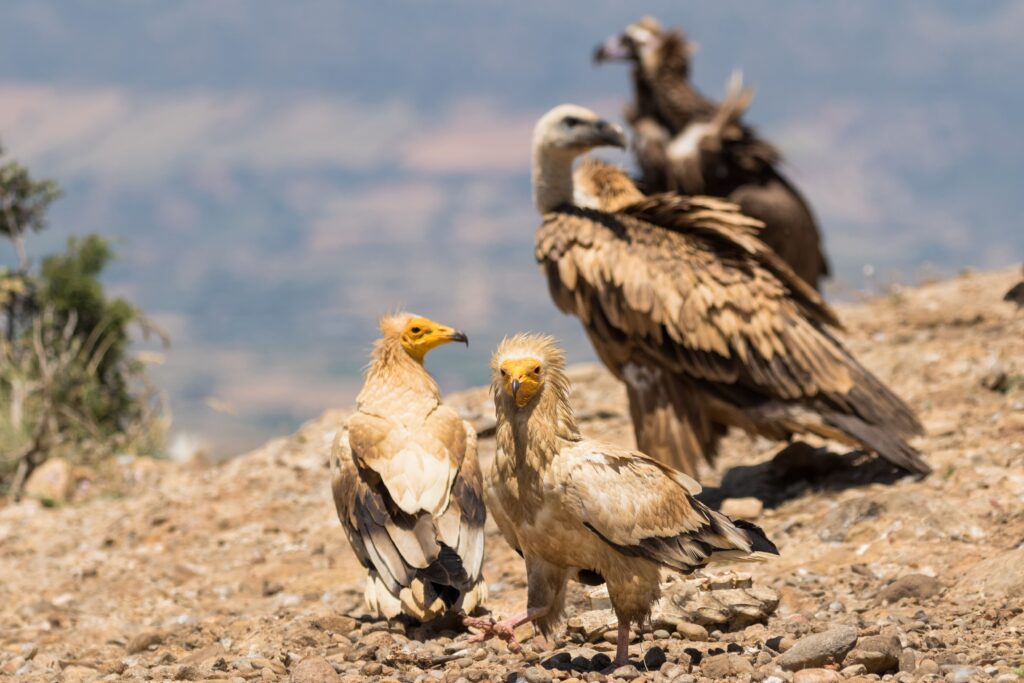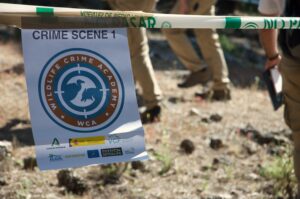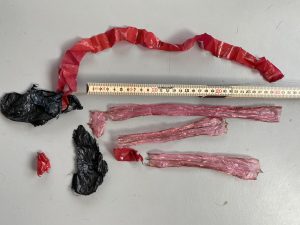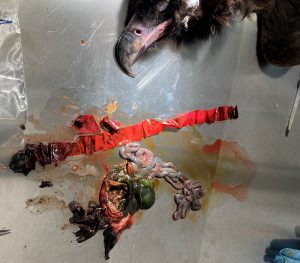Since 1974, World Environment Day has been celebrated globally to focus attention on critical environmental challenges and encourage collective action. Today, we look at the main poisonous substances and human-induced pollution posing a threat to vulture survival, jeopardise the balance of ecosystems and impact human well-being.

Vultures maintain balanced ecosystems
Vultures have an undeniable function in maintaining healthy and balanced ecosystems. As obligate scavengers, they are responsible for eliminating potentially harmful bacteria from decomposing carcasses that could otherwise be a source of contamination and disease outbreaks. Their efficient carcass disposal service releases nutrients into the soil, promoting the nutrient cycle and energy transfer through food webs. It can also help control the population of predators, such as feral dogs, which might be pathogens of diseases.
In case of poisoning incidents, vultures regularly monitored with GPS tags can sound the alarm for poisoned baits and animals if local teams swiftly detect and remove the poisoned carcasses. Apart from the cultural and spiritual dimension they offer, vultures can help reduce the costs of livestock producers that need to pay for the disposal of their dead animals.
The need to tackle poison to restore vulture populations in Europe
By the 1960s, the decreasing availability of food, along with illegal persecution, habitat loss, poisoning, and other human-induced threats, led to the disappearance of vulture species from most of its European range. Populations of Cinereous Vultures, Griffon Vultures, Bearded Vultures and Egyptian Vultures were highly affected, resulting in smaller and isolated breeding colonies, which became locally extinct in some regions.
Thanks to the conservation efforts of hundreds of organisations involved in restocking and strengthening vulture populations, most vulture species show a positive growth trend, according to the “Population estimates report for the Five European Vulture Species” published by the Vulture Conservation Foundation in 2022. However, for reintroduction and restocking measures to be effective, it is fundamental to tackle the main threats affecting their survival. Concrete conservation actions in Europe span from increasing food supply and habitat conditions, securing electricity infrastructure and power lines, decreasing illegal killing and human disturbance, and fighting illegal poisoning by empowering agents and national authorities in criminal investigation and law enforcement.


Breaking the cycle of death by poisoning
Poisonous substances have a dreadful effect on the environment and vulture populations. The illegal use of toxic substances is often an attempt to resolve human-wildlife conflicts, targeting certain species that impact agricultural productivity (such as insects, mammals, rodents and carnivores). However, this indiscriminate practice has a ripple effect on many other species, entering the trophic cascade with consequences for entire ecosystems and posing a risk to human health. Vultures, for instance, can be directly affected by eating from the poisoned baits or indirectly by feeding from animals poisoned to death. A recently produced animation video by the BalkanDetox LIFE project illustrates the vicious cycle of death by poisoning.
The contamination can go unnoticed, leading unsuspecting individuals to consume meat, crops, or water tainted with these harmful substances. As a result, they may suffer from severe health problems, ranging from acute poisoning to chronic illnesses, organ damage, and in the worst cases, even death. With the BalkanDetox LIFE project, we are involved in a concerted effort to respond timely and prevent cases of illegal poisoning, together with many partners and multilevel stakeholders across the Balkans.
Lead: a toxic compound that contaminates habitats, species and human well-being
Other poisoning sources affect vulture population dynamics. Lead, a toxic compound contained in game ammunition projectiles dispersed in the environment on each shot, contaminates soil and water, putting at risk at least 135 million birds each year from direct ingestion and 14 million birds from secondary ingestion. As lead is not eliminated from organisms, its impacts span along the trophic chain, a phenomenon called bioaccumulation, with sub-lethal and sometimes lethal consequences for vultures. A study realised in Spain in 2020 found abnormal blood levels of lead in 30% of Bearded Vultures and 95% of the wild Griffon Vultures captured and included in the study—a silent threat for vultures, causing long-term population declines that are difficult to detect.

As for human health, the ingestion of lead can cause adverse effects on all major body systems, with neurodevelopmental risk (IQ reduction) in children and cardiovascular effects in adults reported. Recent research estimated that the continued use of lead ammunition, associated with impacts on wildlife, people and the environment, costs €383 million–€960 million per year across the EU. The new EU regulation that forbids the use of lead ammunition in wetlands was a stepping stone towards decreasing the impact of this poisoning compound. Whilst a total phase-out is not in place, we are addressing the problem by raising awareness and helping hunters transition to lead-free alternatives within the LIFE Aegypius Return project.
The threat of plastic pollution
Around the globe, over 380 million tons of plastic are produced yearly, from which at least 10 million end up in our oceans. As plastic takes several thousands of years to decompose, macro plastic debris is mistaken by prey, and consumed by many species, affecting primarily marine wildlife and birds. Although plastic is not directly toxic, its ingestion leads to blockages in the digestive system and nutritional deprivation, often lethal. Entanglement is also a significant cause of death, causing severe injuries, drowning or suffocation. Microplastics, for instance, are absorbed by species such as muscles that enter our food supply chain and are consumed by humans. Although there are limited studies on the impact of plastic on human health, studies on rodents demonstrated that microplastics can adversely affect the digestive system and reproductive organs.

The impact of plastic pollution on Vultures
When it comes to vultures, there needs to be more research on the impacts of plastic ingestion. It is known, though, that some vulture species feed in landfills, especially during food shortage periods. As plastics are usually abundant in rubbish dumps, mixed with organic waste, many species ingest plastic, mistaking it for food, causing severe internal injuries. In 2021, a Cinereous Vulture starved to death after eating rubbish bags and plastic strings used to seal rubbish bags. The load of plastic in its stomach revealed during the necropsy, blocked the vulture’s digestion. Other large birds, such as White Storks, are also particularly affected. Na investigation in Switzerland showed that more than a third of dead young storks previously ingested plastic.


A recently published study was held in the United States of America to determine the extent and type of plastic ingested by Black and Turkey Vultures in urban environments. The authors collected and dissected pellets from congregation sites and found plastic materials in sixty per cent of pellets. The consumption of plastic materials was higher on congregation sites surrounded by a greater density of commercial food providers (shops and restaurants).
When plastic waste is not directly ingested, it is often transported and dispersed by animals to faraway sites. A study with Andean Condors, Black Vultures and Turkey Vultures in Northwestern Argentine Patagonia found plastic debris in pellets up to 56 km away from the nearest rubbish dump and on an island within a national park where there is no human presence, confirming that vultures play a role in transporting plastic through the wider landscape, causing local pollution.
#BeatPlasticPollution on World Environment Day 2023
World Environment Day was established by the United Nations General Assembly in 1972, motivated by the need to address pressing environmental concerns and promote a healthy future for our planet. The first celebration was in 1974 with the theme “Only One Earth”, and since then, organisations worldwide have promoted awareness-raising events and campaigns and reinforced policy advocacy, reminding everyone to play a role in protecting the environment.

This year, the focus is on beating plastic pollution. Since 2018, the European Union has been making efforts towards reducing plastic waste, within an EU Strategy, with some critical measures already in place, such as the ban on certain single-use plastics. Recently, The United Nations Environmental Programme launched a new report that sheds light on new economic and business models needed to address the impacts of plastics on the world’s economy. The primary shifts will require industry and individuals to reuse and recycle plastic materials better and reorientate the market towards valuing plastic alternatives and sustainable solutions.



